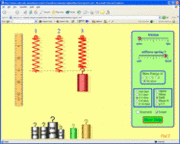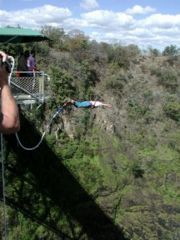Interactive Science Lessons/Hooke's Law
| Hooke's Law |
Introduction | Getting started | The simulation | Lesson tasks | Conclusion | Resources and links |
Introduction
This is an interactive science activity (ISA) that uses the Mass and Spring Flash simulation to explore Hooke's Law. The simulation was created by the Physics Education Technology Team (PhET) at the University of Colorado.
Hooke's law is everywhere! We find it applies to solids, liquids, and gases in many fields of physics. The simplest way to see Hooke's law in action is observe springs, pendulums, or balls in a bowl. It leads to the description of simple harmonic motion and waves, including sound and light waves. Do you want to understand light, sound, the configurations of DNA? Follow me to where it all starts!
One of the most heart stopping applications of Hooke's law is Bungee (or Bungy) jumping as featured in the opening scene of GoldenEye, the 17th James Bond 007 film released in 1995. To make sure that the bungy cord is not too long, bungy operators like Kiwi A.J. Hackett, the first operator of a commercial bungee jump, need to calculate how far the cord will stretch.
Hooke's law also allows us to control light, and our eyes are just one example of a highly evolved material the controls light and directs it to the optic nerve. Small imperfections cause us to be short- or far-sighted. Enter the optometrist, the eye doctor, who again applies Hooke's law to correct our vision with glasses or contact lenses.
Explore Hooke's Law:
|
Activities
Multichoice Question
One of the masses is hooked onto a spring. The mass and spring soon come to rest. Which free body diagram best represents the forces on the hanging mass when it is at rest?
(a)  |
(b)  |
(c) 
|
Reflection
Main Activity
There are three ways to complete the Hooke's Law activity. Click on the highlighted link below that is the closest match for your situation.
| Self-guided Activity | Guided Activity | Group Activity |
|---|---|---|
| Comfortable with the simulation | Uncomfortable with the simulation | Sharing a computer |
| Answered the multi-choice question correctly | Experienced difficulties with the multi-choice question | Working in a Team |
| Already have a hypothesis | Not sure of a hypothesis | |
| Ready for a challenge | Ready for small steps |
Conclusion
Check Your Results
| You have finished your activity! Let's see how you did. What is the spring constant of Spring #1?
The spring constant for Spring #1 is 10 N/m. Good work! You are well on your way to learning about simple harmonic motion. Simple harmonic motion describes waves including light and sound waves. The world would be a very boring place with out them. To go to an interactive science activity on simple harmonic motion see your teacher or click on the this link Simple Harmonic Motion. |
Wrap Up
We would like to acknowledge the open source resources that we used in this activity. Without them this activity would not be possible.
- Physics Education Technology Team (PhET) at the University of Colorado for creating the Flash Simulation.
- Peter Jipsen at the Chapman University for creating the javascripts for scalable vector graphics (ASCIIsvg.js) and MathML (ASCIIMathML.js).
- OsterMiller.org for creating a web-based scientific calculator.
Tell us your thoughts
Give us some feedback:
* What was the most interesting part of the activity? * What was the most difficult part of the activity? * What could be improved?
Send your comments to: myName@myAddress.org
Resources
This section provides educator resources. This activity was originally created using eXe an e-learning XHTML editor and ported to wiki format. The eXe file and a website export can be downloaded by clicking on the appropriate link below.
Hooke's Law.zip (Website archive from an eXe export)
Definitions
mass
weight
displacement
force
free body diagram
equilibrium
slope
click and drag
Navigate the cursor over the object you wish to move. Click and hold the (left) mouse button. Drag to object to the desired location. Release the mouse button.

